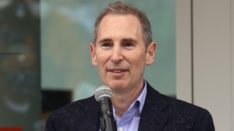Amazon reports Q2 earnings, beating Wall Street expectations but shrinking staff headcount
Amazon reported their second quarter earnings on Thursday, with the results seeing Amazon shares climb more than 13% in extended trading and providing a positive guidance for Q3.
Amazon reported revenue of US$121.23 billion vs. US$119.09 billion expected in its 2022 second quarter, bolstering confidence for the third quarter.

Amazon CEO Andy Jassy.

